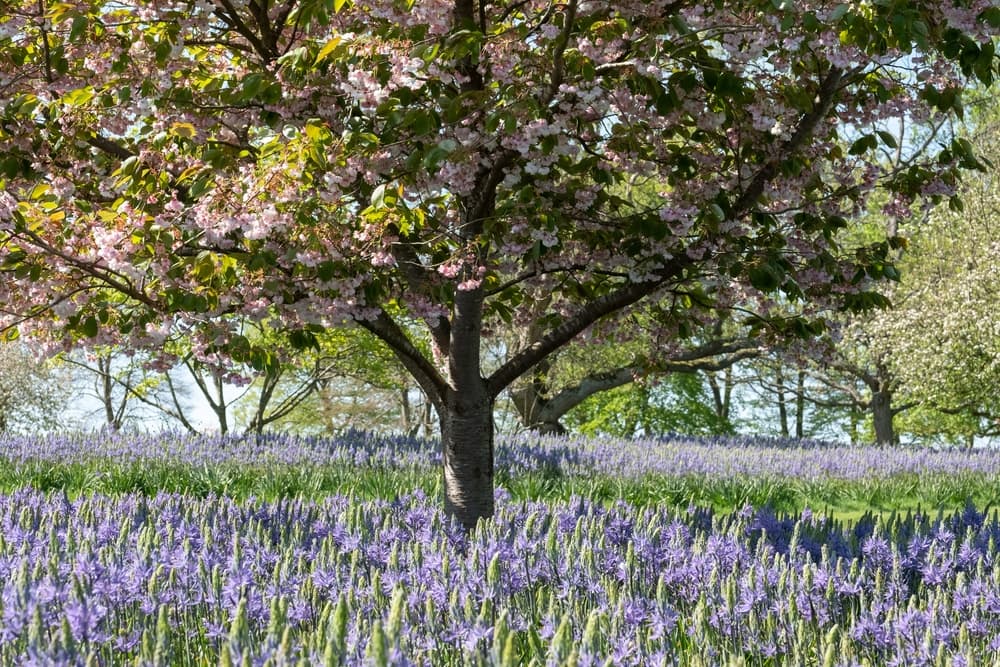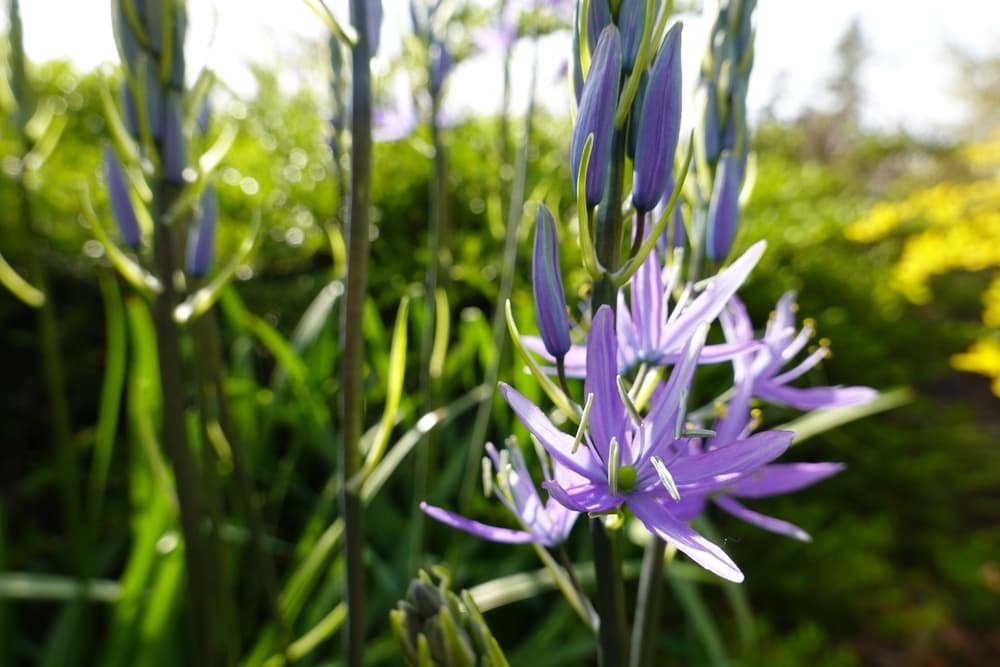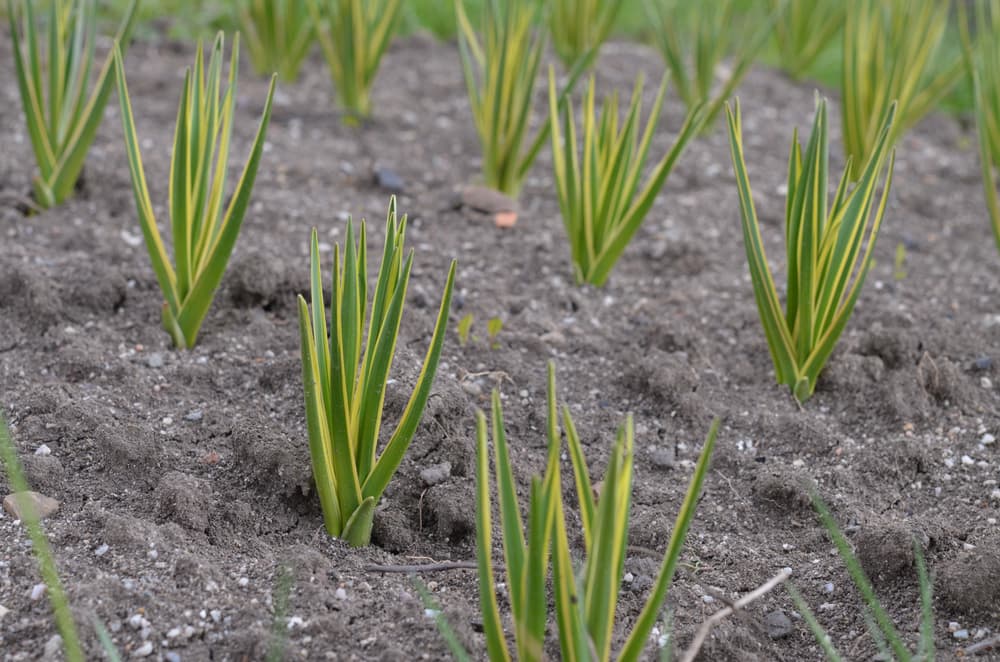BULBS > CAMASSIA
Reviewed By COLIN SKELLY

Colin is a Horticulturist and Horticultural Consultant with experience in a range of practical and managerial roles across heritage, commercial and public horticulture. He holds the Royal Horticultural Society’s Master of Horticulture award and has a particular interest in horticultural ecology and naturalistic planting for habitat and climate resilience.
CAMASSIA GUIDES
Six-tepalled, star-like blooms in dense flower-laden racemes on erect stalks in pastel tones and deep shades of purples will adorn your garden if you plant a few Camassias.
This very reliable, virtually no-care perennial bulb plugs that spring-to-summer transition season.
It hails from the sunny prairies and moist meadows of the United States where it paints the landscape in big, broad blazes of colour.1Camassia. (n.d.). North Carolina Extension Gardener Plant Toolbox. Retrieved March 13, 2023, from https://plants.ces.ncsu.edu/plants/camassia/
Camassia is a long-lived deciduous perennial that has probably flown under the radar of a goodly number of gardeners.

This easy-grow and very well-behaved bulb will keep coming up year after year and naturalise in your garden, but ever so gradually and ‘tactfully’.
You don’t have to worry about Camassia pulling a no-show, and you don’t have to worry about Camassia taking over your garden.
Overview
| Botanical Name | Camassia |
| Common Name(s) | Camas, Quamash, Wild Hyacinth, Camosh |
| Plant Type | Perennial Bulb |
| Native Area | Western North America |
| Hardiness Rating | H4 |
| Foliage | Deciduous; Grass-like |
| Flowers | Six-tepalled, star-shaped blossoms |
| When To Sow | September, October |
| Flowering Months | May, June |
Sunlight
Preferred
Full Sun / Part Shade
Exposure
Sheltered
Size
Height
0.5 – 1.5M
Spread
0.1 – 0.5M
Bloom Time
May – June
Soil
Preferred
Any
Moisture
Moist but well drained
pH
Any
Camassia, also called Camass Lily, actually originally used to be classified with Lilies in Family Liliaceae.2Camassia scilloides (Wild Hyacinth) Liliaceae. (n.d.). Lake Forest College. Retrieved March 13, 2023, from https://www.lakeforest.edu/academics/majors-and-minors/environmental-studies/camassia-scilloidesand160(wild-hyacinth)-liliaceae
After the usual Botanical shuffles and reshuffles, Camassia’s lot fell with Asparagus in Family Asparagaceae!3Camassia. (n.d.-b). Pacific Bulb Society. Retrieved March 13, 2023, from https://www.pacificbulbsociety.org/pbswiki/index.php/Camassia
And this factoid brings us to a third name for this plant – in most parts of the United States it still goes by what the pioneers called it: Camas, a phonetic simplification of the Native American name.

Camassia includes all of six species and a handful of cultivars.
While the species range quite widely in height, running from only about 30 centimetres all the way to 1.3 metres, all varieties – species and cultivars – have similar foliage which comprises of clumps of narrow linear leaves.
This bulb starts blooming after Tulips have displayed their charms and shut up shop.
Camassias light up gardens and meadows between Flowerdom’s two peak seasons, producing blooms through May and moving into June.

Colours include creamy white, and shades of blue and purple from the palest lilac through to the deepest violet.
The bright, sunny yellow stamens make a striking contrast on the flowers that are in brilliant hues of purple and violet.
How To Grow Camassia
Like most bulbous plants, the straightforward way to grow Camassia is through bulbs.
It is possible to grow them from seed but that method is not a very easy way to propagate what is an easy-care plant.
Also, seed-grown Camassias bloom after at least three years and even more.

You should choose bulbs that are large, evenly shaped, firm to the touch, and do not show any nicks or any loss of the bark-like covering or skin.
Where To Plant
First off, though Camassia can be planted in containers they do not do as well as they do in open ground for various reasons.
Visually too, a Camassia will look awkward in a container; furthermore, it cannot offer anything at all in autumn and winter.
Camassias in bloom make a huge visual impact when they cover a sizeable area of land and, therefore, mass plantings are a great way to go.
Try planting at least 15 bulbs in irregular drifts – Camassia flowers will look especially lovely on verges and slopes.
They can be mixed in with other bulbs such that their respective blooming seasons segue from one to the other so that you can enjoy flowers on the same patch of land from earliest spring to the end of summer.

Otherwise mix them up with spring wildflowers with which Camassias’ simple blooms will mingle well.
These flowers can be utilised to create a wildflower meadow effect, as Horticultural Consultant Colin Skelly shares:
“I like to plant Camassia bulbs in damp meadow gardens, filling a gap between spring and later summer flowering bulbs and perennials.”
This well-behaved bulb is not remotely invasive yet naturalises wonderfully well; as such, it will give pleasure for many years and also keep springing a surprise now and again.
Finally, this moisture-loving plant will do very well beside a stream or pond as long as the soil is not overly damp in autumn and winter.
How To Plant
Bulbs are best planted in the September through November timeframe.

Water the soil moderately before digging holes.
The planting depth should be two to three times the length of the bulbs.
Bulbs should be spaced at least 10 centimetres, and up to 20 centimetres, apart. The pointed tip should be upwards.
After filling up the hole, do not pack the soil but give the ground a good watering so that the soil is firmed up.
Plant Care
You don’t have to maintain these plants in any way; all you need to do is ensure the soil does not dry out during the growing season – keep it consistently moist.
Indeed, one might say that Camassias thrive on neglect and moisture!
Soil Requirements
Though almost any soil will do for this sporting bulb, a fertile loam amended with humus is ideal.
As a ‘moisture-loving’ bulbous plant Camassia does not object to damp or heavy soils in spring and summer.

But when the bulb is dormant in autumn and winter, waterlogged soil can prove fatal; therefore, soil should be well drained.
However, the plant prefers moist soil.
As for soil pH, here too Camassia is unfussy but anything from Slightly Acidic to Slightly Alkaline will be just right.
Preferred Aspect
A location where the plants get full sun, or full sun in the morning and filtered or dappled sun in the afternoon is best – partial shade will do.
Mulching & Feeding
Fertilising is strictly optional.

Every couple of years the soil may be amended with some humus or a light sprinkling of bone meal may be worked into the soil though it must not be allowed to make contact with the bulb or stem.
If you anticipate a hard frost in winter, apply a good layer of mulch.
Pruning
Cut back stalks after the flowers are spent.
Allow the leaves to yellow and do not prune or cut back as the foliage synthesises energy to replenish the bulb.
It is this store of energy that sets up the bulb to push up stalks and to produce flowers the following year.

Leaves should be cut back only after they have turned brown and withered.
As a rule, Camassia bulbs should not be disturbed.
However, if you have decided to separate and divide offsets, this can be done end of autumn to early winter when the bulb is dormant but before winter chill sets in.
One of the big positives of Camassias is that they are not known to suffer from any particular pests or diseases.
Buying Camassia

A large selection of these plants may well not be available at your neighbourhood nursery but a few of the popular varieties will likely be on display.
Both potted plants and bulbs are usually in stock at several, though not very many, online stores.
Buying bulbs is the better option.
If you can find a merchant that sells a mix of 20 to 30 bulbs of several different varieties, then that would be a great buy.
References
- 1Camassia. (n.d.). North Carolina Extension Gardener Plant Toolbox. Retrieved March 13, 2023, from https://plants.ces.ncsu.edu/plants/camassia/
- 2Camassia scilloides (Wild Hyacinth) Liliaceae. (n.d.). Lake Forest College. Retrieved March 13, 2023, from https://www.lakeforest.edu/academics/majors-and-minors/environmental-studies/camassia-scilloidesand160(wild-hyacinth)-liliaceae
- 3Camassia. (n.d.-b). Pacific Bulb Society. Retrieved March 13, 2023, from https://www.pacificbulbsociety.org/pbswiki/index.php/Camassia


